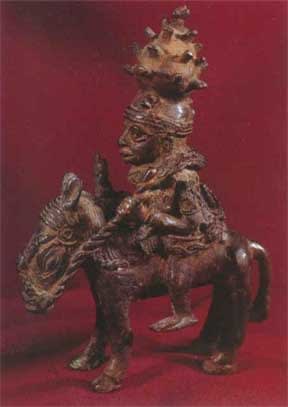Benin Bronze/Brass Equestrian Sculpture, 1725 CE - 1800 CE
Bronze/Brass
8.75
PF.4004 (LSO)
This imposing brass sculpture of a man on horseback was made by a master metalworker of the ancient kingdom of Benin. It represents an Oba – one of the polity’s...
This imposing brass sculpture of a man on horseback was made by a master metalworker of the ancient kingdom of Benin. It represents an Oba – one of the polity’s hereditary God-Kings – wearing ornate ceremonial robes drawn up to his waist, clutching the reins in his left hand and a sceptre in the other, clad further in jewellery around his neck and arms, and surmounted by a truly enormous, spiky headdress attached to the apex of a cap that covers his head down to the brows. The horse is elongated but otherwise roughly to scale, unlike Yoruba equestrian pieces in which the rider dwarfs his mount. It stands full-square, its head pointing down, and is wearing a very ornate halter and apparel, and would seem to be attired for some ceremonial occasion. The piece is darkly patinated.
In the eyes of the Benin populace, the Obas were divine beings, and paraphernalia such as this was created after their demise in order to be displayed on altars dedicated to their memory. Until the late 19th century, the Benin centres were a ruling power in Nigeria, dominating trade routes and amassing enormous wealth as the military and economic leaders of their ancient empire. This changed with the appearance of British imperial forces, which coveted the wealth of the royal palaces and found a series of excuses to mount a punitive expedition against the Oba’s forces in 1897. It was only at this point, the moment of its destruction, that the true achievements of the Benin polities became apparent to western scholars.
Benin royal palaces comprised a sprawling series of compounds containing accommodation, workshops and public buildings. As it grew, the buildings pertaining to previous Obas were either partially refurbished or left in favour of newer constructions; this led to a long history of royal rule written in sculptural works that rank among Africa’s finest; until European industrial advances in the 19th century, they were the finest bronzes that ever made. Metal Oba heads were used to honour the memory of a deceased king. Typically, the son of the dead king – the new Oba – would pay tribute to his father by erecting an altar in his memory. These altars were decorated with various artefacts alluding to the Oba’s achievements in life. These heads were typically arranged in pairs, each supporting an elephant’s tusk that was inserted through the hole in the top of the head. Further decorations included spears, statues, cast brass objects depicting the Oba and his followers, brass bells to awaken the spirits, rattle-staffs (ukhurhe) and magical objects that included Neolithic celts (known as “thunder stones”). The new king would pay homage to his father in this way, guaranteeing the succession and demonstrating the continuity of divine kingship.
Dating these pieces is fraught with difficulty as many were taken from their context without recording of important factors and associations. Given the style, patina and signs of usage, one can tentatively assign it to the mid eighteenth to early 19th century, although it may predate this. Taken as a whole, the piece is remarkably effective, powerful and well-rendered, and would take pride of place in any serious collection of African art.
In the eyes of the Benin populace, the Obas were divine beings, and paraphernalia such as this was created after their demise in order to be displayed on altars dedicated to their memory. Until the late 19th century, the Benin centres were a ruling power in Nigeria, dominating trade routes and amassing enormous wealth as the military and economic leaders of their ancient empire. This changed with the appearance of British imperial forces, which coveted the wealth of the royal palaces and found a series of excuses to mount a punitive expedition against the Oba’s forces in 1897. It was only at this point, the moment of its destruction, that the true achievements of the Benin polities became apparent to western scholars.
Benin royal palaces comprised a sprawling series of compounds containing accommodation, workshops and public buildings. As it grew, the buildings pertaining to previous Obas were either partially refurbished or left in favour of newer constructions; this led to a long history of royal rule written in sculptural works that rank among Africa’s finest; until European industrial advances in the 19th century, they were the finest bronzes that ever made. Metal Oba heads were used to honour the memory of a deceased king. Typically, the son of the dead king – the new Oba – would pay tribute to his father by erecting an altar in his memory. These altars were decorated with various artefacts alluding to the Oba’s achievements in life. These heads were typically arranged in pairs, each supporting an elephant’s tusk that was inserted through the hole in the top of the head. Further decorations included spears, statues, cast brass objects depicting the Oba and his followers, brass bells to awaken the spirits, rattle-staffs (ukhurhe) and magical objects that included Neolithic celts (known as “thunder stones”). The new king would pay homage to his father in this way, guaranteeing the succession and demonstrating the continuity of divine kingship.
Dating these pieces is fraught with difficulty as many were taken from their context without recording of important factors and associations. Given the style, patina and signs of usage, one can tentatively assign it to the mid eighteenth to early 19th century, although it may predate this. Taken as a whole, the piece is remarkably effective, powerful and well-rendered, and would take pride of place in any serious collection of African art.
Literature
V19
